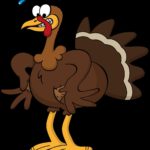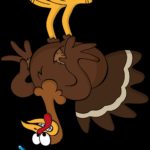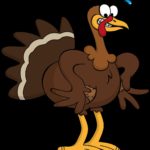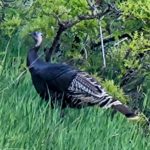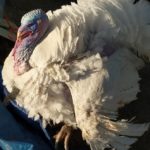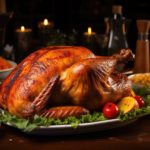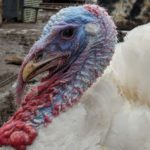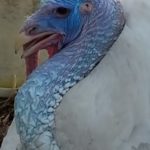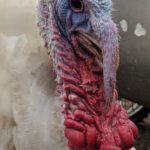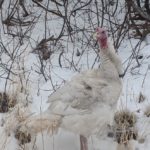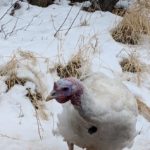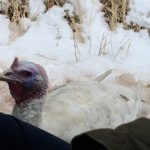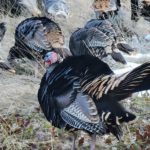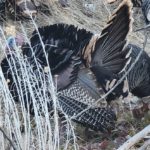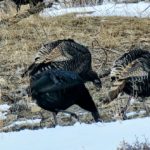One of my earliest recollections regarding a bird whose crossed star rises every fall here in north America, the turkey, occurs in Kindergarten.
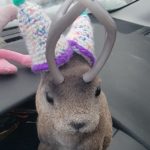
One day, in late fall, My classmates and I were put to the task of coloring in a line drawing of a turkey, using crayons. I remember feeling awed by this handsome bird with a spectacularly fanned tail. Although, wild turkey do inhabit the windy plains of Wyoming, I hadn’t seen one in real life. (Hunting the elusive jackalope was my primary preoccupation when out of doors). Despite a lack of formal familiarity, however, I distinctly remember having a very clear idea of how I wanted to color this picture.
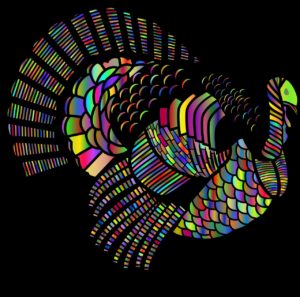
I began with blacks and browns over which I gradually built up layers of color; adding reds, blues and yellows. I wanted to create a sheen that shimmered like a magical rainbow over the dark base as seemed befitting of this bird. Unfortunately, the school grade print paper canvas was not up to the task. As I pressed harder and harder onto the over saturated surface, crayon flakes, like so many unruly autumn leaves scattered helter-skelter. This chaos of pigment left smudges of multicolored stains around the margins blurring the image. The harder I worked, the worse things got. I had aimed for a particular perfection, but what I ended up with was a perfect mess: Hands, paper, desk. The stern look on my teachers face, gave a final confirmation that my efforts had gone awry.
I had wanted to display, through my artwork, a nobility and beauty that I innately felt was true about this bird, but what actually appeared on the paper was an amorphous scribble obscured by cloudy smudges.
I find in this long ago memory a kind of metaphor for how this remarkable feathered folk has been perceived or rather misperceived by the general American public for the past three quarters of a century or so.
Today, I am about to right that long ago mishap, however and paint for you a better picture.
I’m flipping the bird.
Don’t get your knickers in a twist, just hold on tight to those tail feathers.
It’s time to turn ignorant stereotypes topsy-turvy, and bring clarity to the somewhat murky reputation surrounding this truly indigenous American bird that we call turkey.
Which comes to mind when you think about the American Turkey? Do you picture a lean, bold colored bird with with a keen, alert look in its eye?
Or do you picture something more like the buxom snowy tom aimlessly meandering the white house lawn in late November, ready to be pardoned for the sole crime of being a favorite “guest” at the holiday table?
Do the words, bravery, or fidelity, agility and cunning come to mind?
No?
To be certain, in the current zeitgeist to be called a turkey or to label something a turkey carries a distinctly negative connotation; meaning something along the line of second rate, stupid or cowardly.
But let’s back it up a bit and take a longer view.
The American Turkey (meleagris gallopavo) bears such an ironic misnomer, as it does not and never has existed in the country it is rumored to have been mistakenly named for. The heaviest member of the galliformes, this bird has been revered for centuries by the indigenous inhabitants of the Americas. To this day, the turkey is honored among different tribes as a clan name.
 Domestication is nothing new to this bird. Mesoamerican people began husbandry of this ground nesting avian around 300 b.c.e. The huexolotl, as the wild turkey was called among the Nahuatl speaking people became the totolin; a domesticated version that was kept not just for meat, but also for symbolic value and for the use of their beautiful feathers.
Domestication is nothing new to this bird. Mesoamerican people began husbandry of this ground nesting avian around 300 b.c.e. The huexolotl, as the wild turkey was called among the Nahuatl speaking people became the totolin; a domesticated version that was kept not just for meat, but also for symbolic value and for the use of their beautiful feathers.
Even after the Europeans arrived, the turkey did not suffer in reputation for centuries. Rather it was acknowledged as a valuable resource and a beautiful and unique American bird.
It wasn’t until the 1920s that the reputation of the turkey took at tail spin.
What changed?
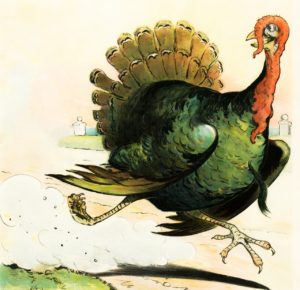
The dawn of commercial farming instigated processes that would leave negative impacts on both the consumed and the consumer for generations to come.
Let me insert another memory here:
During my early teen years, I lived in a rural area of Montana. Just outside of the city of Great Falls. A few of my neighbors raised turkeys for meat along with other animals on small five acre farms. I quickly discovered that this was not the same majestic bird I failed to represent with waxy pigments in my grade school days. Although domesticated turkey can and do present with the rich array of feathers that adorn their free range counterparts, the Broad Breasted White (meat) turkey, is ubiquitously, well, white. This has something to do with how the pin feathers show up or don’t show up on a dressed bird. These unlucky creatures have further been saddled with developing overlarge breast, hence, they no longer move with the grace and agility of their wild kin. This is a burden which makes them appear far more clumsy than agile. I remember my peers telling me that turkeys were so dumb that they would drown in rainstorms because they ran around with their mouths open. This it turns out,is a widely circulated myth. From that day on, however, my opinion of turkeys subtly changed.
It wasn’t until years later, after moving to Utah, that I encountered turkey face to face again, wandering the hills of the Wasatch Front.
Nature always seems to offer a generous amount of wisdom and information if one is receptive to it. While I did not have the great fortune of being born into a community that holds a long traditional understanding and mythology of this incredible feathered being, I have, through my observances of and interactions with wild turkey, gleaned something of a window into their true and remarkable character.
Turkey are loyal and intelligent.
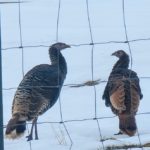 I once observed two wild turkeys assist a third to find a way to transverse a tall wire fence that separated the single bird from it’s mates. Because the fence was on a fairly steep slope, this panicked bird had a difficult time getting enough footing so as to launch itself high enough to clear the barrier outright. Continuously calling to their distressed kin, the two other turkeys located and lodged themselves in a tall fir whose branches happened to overhang the fence. After locating his mates, the frightened bird was able to fly to the lowest of the branches and make his way to freedom and back to its two relieved companions.
I once observed two wild turkeys assist a third to find a way to transverse a tall wire fence that separated the single bird from it’s mates. Because the fence was on a fairly steep slope, this panicked bird had a difficult time getting enough footing so as to launch itself high enough to clear the barrier outright. Continuously calling to their distressed kin, the two other turkeys located and lodged themselves in a tall fir whose branches happened to overhang the fence. After locating his mates, the frightened bird was able to fly to the lowest of the branches and make his way to freedom and back to its two relieved companions.
Turkey are naturally agile, and they can fly.
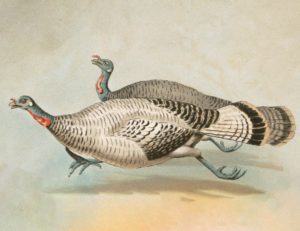 Watching a flock of turkeys run ninja like through thick underbrush, a person quickly realizes these birds are anything but bumbling or clumsy. It is a scientific fact that wild turkey have very keen eyesight and can travel on the ground at speeds ranging from 18 to 30 mph. On the wing they can reach speeds up to 60 mph. Though their flight paths are only for about 100 yards or so, they easily can wing it up a tall tree to escape predators.
Watching a flock of turkeys run ninja like through thick underbrush, a person quickly realizes these birds are anything but bumbling or clumsy. It is a scientific fact that wild turkey have very keen eyesight and can travel on the ground at speeds ranging from 18 to 30 mph. On the wing they can reach speeds up to 60 mph. Though their flight paths are only for about 100 yards or so, they easily can wing it up a tall tree to escape predators.
Turkey have a complex language.
Turkey vocalizations, vary greatly in tone and inflection. Sometimes they are so subtle that you hardly notice them. The “gobble gobble” that everyone associates with turkeys is something I hear less frequently in the wild than I do the soft staccato notes that almost sound like drops of water, or the purling chortle of a hen to her chicks. This is an awesome video I found on YouTube regarding how intricate and advanced turkey language is.
Turkey are a bird of many colors.
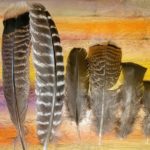
Wild turkeys can display albinism, which means they can be mostly white, but that is not common. These birds actually have up to five different morphs from smoke, to cinnamon, to blue… The radiant variety of iridescen\e is truly breathtaking in these bird folk which makes their feathers one of my favorites.
But what about that strange naked head you ask?
Well, it turns out, that similar to vultures, turkey have evolved with a natural cooling and heating regulator, and that is the (mostly) naked neck. Also, the color of a toms neck, including wattle and snood – that top dangely bit – changes colors from blue to purple to pink to red to a mottled variation based on their emotional state. Move over mood rings!
This last fact, incidentally, is something my daughter and I discovered after rescuing a domestic tom from *abandonment in the foothills along the Wasatch front.
This giant white behemoth was so terrified that it didn’t take much to get him to hop into the car and happily hunker down on my lap for the ride home. As the car warmed and he settled, his neck and wattle morphed from shy salmon to a pacified periwinkle. What a surprise! What further astonished us, apart from the size of his feet, (the impression he left in the snow was reminiscent of a tiny T-rex, which is to say huge) was the affection and curiosity he demonstrated as soon as he felt safe. This goes to show that even the domestic turkey defy the stereotypes.
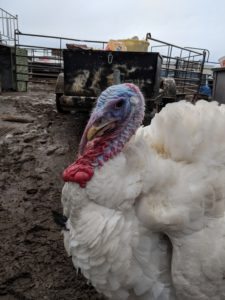
Our rescue tom eventually found a wonderful home with a dear friend who made room in her hen house for this giant “chicken”. He lived quite happily ever after to the ripe old age of at least 3 or 4. Which is quite old for a turkey meant to be dinner by 6 months of age.
I am currently in the process of taking an online Tarology class from Jungian Dream Analysis Scholar, poet, student of the occult, current PHD candidate and self proclaimed shape-shifter (sometimes she’s a cat…how fantastic!), Elianne El-Amyouni.
She is known in her social media accounts as Twitchy Witch and I highly recommend her content to anyone who is interested in Jungian concepts, alchemy, religion, poetry, music and middle-eastern studies.
Wait…what does this have to do with turkeys? I can hear you thinking this question…yes I can!
As Elianne puts it. Everything is a symbol. All the things we work with and experience most closely become our most important, personal symbols. Elianne further goes on to elucidate; “…a symbol is a sort of gesture to what is wordless, what cannot be bound in total linguistic comprehension, but can be felt”.
The chance meeting with a certain creature can carry a message that is as individual and mutable as life itself. It is in the relationship that is developed towards an individual creature or collective, through observation and interaction, that the symbol becomes revealed.
Just as the indigenous peoples from ancient times understood, I am understanding more and more that it is through this meta-language, that deeper knowing is recognized and higher knowledge is understood.
When I encounter the wild American turkey, I am reminded that community fosters bravery and fidelity. I am awed by language that is beyond my understanding but that is also universal in it’s aspect of communicating care. I am made aware that true beauty is not always evident but is revealed; through sudden shafts of sunlight igniting a hidden jeweled iridescence – through the astonishment that ever enraptures with every unfolding of the turkeys majestic tail.
As a collective and as a symbol, I honor this bird each time we meet and I hope turkey will continue to show me further wisdom.
As ever, happy wandering!
Juni -Jen
*A bit about animal abandonment and dumping in wilderness spaces. If you see this happening in your area please report it. This act is not good for the domesticated creature who has not been raised with the skills to thrive in such an environment, nor is it good for the environment as it can introduce disease or threaten natural populations.

